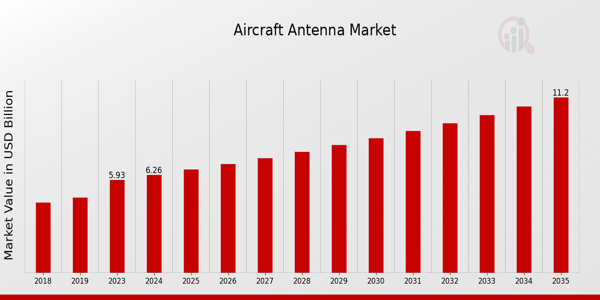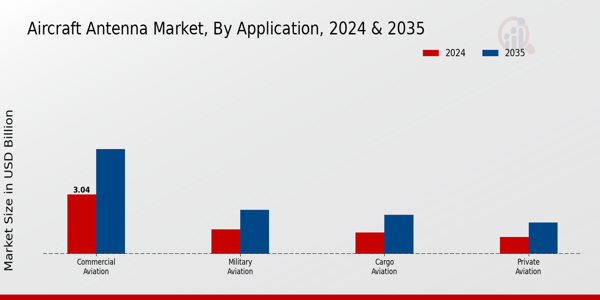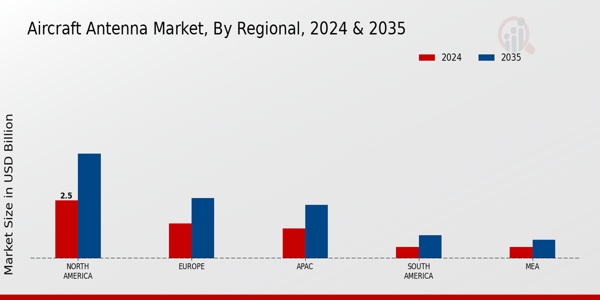Global Aircraft Antenna Market Overview:
Aircraft Antenna Market Size was estimated at 5.93 (USD Billion) in 2023.The Aircraft Antenna Market is expected to grow from 6.26(USD Billion) in 2024 to 11.2 (USD Billion) by 2035. The Aircraft Antenna Market CAGR (growth rate) is expected to be around 5.44% during the forecast period (2025 - 2035).

Source: Primary Research, Secondary Research, MRFR Database and Analyst Review
Key Aircraft Antenna Market Trends Highlighted
The growing need for sophisticated navigation and communication systems in both commercial and military aviation is propelling the global aircraft antenna market's notable expansion. Two major factors propelling the market ahead are the increase in air travel and the requirement for better in-flight connections.
High-performance antennas that can support Wi-Fi and high-bandwidth data services are becoming more and more important as airlines place a higher priority on the traveler experience. Additionally, the need for creative antenna designs has been highlighted by aircraft's transition to increasingly complex networks, such as satellite communications.
Opportunities in the market are emerging from technological advancements, particularly in the development of next-generation antennas that offer enhanced performance and efficiency. The adoption of phased arrays and electronically steerable antennas is increasing, allowing for improved signal quality and broader coverage.
Additionally, the trend toward UAVs (unmanned aerial vehicles) in commercial applications is creating a niche for specialized antennas tailored for these platforms. Moreover, collaborations between key stakeholders in the aerospace sector may lead to the development of integrated solutions that cater to various functionality requirements while optimizing operational costs.
In recent times, sustainability has become an important consideration in the design and production of aircraft antennas. Manufacturers are exploring eco-friendly materials and processes to align with global environmental goals. This focus on sustainability is shifting buying preferences and encouraging innovation among suppliers.
Moreover, trends such as the integration of IoT technology with aircraft systems are paving the way for smarter antennas capable of adapting to various operational needs. These dynamic shifts highlight a market that is both innovative and responsive to current and future demands, making it a crucial area for investment and development in the aerospace industry.
Aircraft Antenna Market Drivers
Increasing Demand for Advanced Aircraft Communication Systems
The Global Aircraft Antenna Market is experiencing significant growth due to the increasing demand for advanced aircraft communication systems. With the rise of satellite communications and the need for better connectivity in aviation, aircraft manufacturers and airline operators are investing heavily in advanced antenna technologies.
These systems not only enhance communication capabilities but also enable real-time data transmission, improving flight safety and operational efficiency. As the aviation industry continues to evolve, there is a growing emphasis on integrating sophisticated communication systems in both commercial and military aircraft.
The upward trajectory of the global civil aviation sector, accelerated by a surge in air travel demand, will further enhance the need for innovative antenna solutions that can support high-frequency communication, GPS navigation, and air traffic control requirements.
Moreover, the push for next-generation connectivity solutions, such as 5G networks, is prompting the enhancement of antenna design to meet new operational standards. The increasing acceptance of unmanned aerial vehicles (UAVs) and the need for robust communication in remotely operated aircraft contribute to the substantial growth potential of the Global Aircraft Antenna Market.
Technological Advancements in Antenna Design
Technological advancements in antenna design are driving the growth of the Global Aircraft Antenna Market. Innovations such as smart antennas, multi-band antennas, and beamforming technologies enhance the performance and efficiency of communication systems in aircraft.
These advancements enable aircraft to maintain reliable connections with ground stations, satellites, and other aircraft, contributing to improved safety and operational capabilities.
Coupled with the ongoing trend of miniaturization and integration of antennas into aircraft structures, these improvements are paving the way for more efficient designs that save weight and space while delivering superior performance.
Rising Defense Expenditures and Military Modernization
The rising defense expenditures and military modernization initiatives across various countries are significantly impacting the Global Aircraft Antenna Market.
Nations are investing in advanced military aircraft equipped with state-of-the-art communication and surveillance systems, which require sophisticated antenna technologies. This trend is spurred by the need for enhanced situational awareness, strategic communication capabilities, and improved operations in complex environments.
As defense budgets continue to grow, the demand for specialized antennas tailored for military applications is expected to rise, presenting lucrative opportunities for market players.
Aircraft Antenna Market Segment Insights:
Aircraft Antenna Market Application Insights
The Global Aircraft Antenna Market was characterized by its diverse applications across various sectors, reflecting a robust growth trajectory driven by advancements in technology and increasing demand for air travel.
Commercial Aviation emerged as a major player within this landscape, commanding a valuation of 3.04 USD Billion in 2024, and anticipated to grow to 5.34 USD Billion by 2035, thus holding the majority position within the market. This dominance stemmed from the rising number of passengers and airlines investing in enhanced communication and navigation systems.
Military Aviation, valued at 1.25 USD Billion in 2024 and expected to increase to 2.25 USD Billion by 2035, signified the importance of sophisticated antenna systems for secure communications and real-time data transmission in defense applications. As geopolitical tensions rise, the military sector aims to enhance operational effectiveness, consequently driving demand for advanced antenna technology. Cargo
Aviation, while comparatively smaller, showed growth potential with a valuation of 1.1 USD Billion in 2024, projected to reach 2.0 USD Billion by 2035. The growth in e-commerce and the need for reliable logistics solutions have made cargo aviation increasingly relevant, creating opportunities for specialized antenna solutions that facilitate fleet management and tracking.
In the same vein, Private Aviation held a valuation of 0.87 USD Billion in 2024, projected to grow to 1.61 USD Billion by 2035, appealing to high-net-worth individuals seeking enhanced in-flight connectivity and communication systems.
Although it contributed the least to the overall market figures, it reflected a growing trend towards personalization and luxury aviation, thereby highlighting the increasing importance of integrating advanced antenna systems in private jets.
In summary, the Global Aircraft Antenna Market segmentation showcased a dynamic and evolving landscape where each application played a distinct and crucial role, contributing to the overall market growth driven by technological advancements and changing customer demands.

Source: Primary Research, Secondary Research, MRFR Database and Analyst Review
Aircraft Antenna Market Antenna Type Insights
The market encompasses various antenna types that are critical for communication, navigation, and weather monitoring in aviation systems. Among these, Satellite Antennas are particularly vital, facilitating reliable connectivity and data transmission for both commercial and defense aircraft.
Communication Antennas are significant as they enable clear voice and data communications, ensuring operational efficiency and safety. Weather Radar Antennas play an essential role in enhancing situational awareness by providing pivotal meteorological information, while Navigation Antennas are crucial for maintaining accurate positioning and enabling air traffic control.
The segmentation of the Global Aircraft Antenna Market not only showcases diverse functionalities but also underscores the importance of innovation in enhancing the performance and reliability of these systems. The market growth is driven by increasing air traffic, advancements in antenna technologies, and a heightened emphasis on safety and security in aviation operations.
Aircraft Antenna Market Material Insights
The market segmentation regarding material reveals notable prospects, with various materials like Metal, Plastic, Ceramic, and Composite driving development.
Metal antennas are significant due to their durability and superior signal transmission properties, making them a preferred choice for critical applications. Plastic antennas offer lightweight and cost-effective solutions, which are vital for economic aircraft designs.
On the other hand, Ceramic antennas are gaining traction due to their robustness and ability to withstand high temperatures, which is essential for modern aircraft environments.
Composites are also witnessing growth due to their enhanced performance characteristics and lightweight nature, contributing to overall fuel efficiency. These materials not only enhance aircraft performance but also align with trends towards fuel efficiency and sustainability in the aviation industry, presenting a dynamic landscape for market growth and advancements in technology.
The Global Aircraft Antenna Market data shows a strong upward trajectory, emphasizing the necessity for innovation in material technology to meet evolving industry standards and demands.
Aircraft Antenna Market Mounting Type Insights
The Global Aircraft Antenna Market, particularly in the Mounting Type segment, showcases significant growth and evolution.
The segmentation of the market into Top Mounted, Side Mounted, and Integrated mounting types plays a crucial role in addressing various aviation requirements. Top Mounted antennas dominate this segment due to their enhanced performance characteristics, particularly in maximizing signal coverage and minimizing interference.
Side-mounted antennas cater to specific aircraft designs, providing tailored solutions that enhance aerodynamics while maintaining robust communication capabilities. Integrated mounting types are gaining traction primarily due to their streamlined design, which contributes to weight reduction and efficiency in aircraft operations.
Overall, the trends indicate that technological advancements along with the increasing need for reliable communication systems are driving the market growth, while challenges such as regulatory compliance and integration costs continue to pose obstacles in this evolving landscape.
The Global Aircraft Antenna Market data underscore the growing importance of these mounting types in enhancing aeronautical functionality, thus defining the landscape of the aviation industry in the coming years.
Aircraft Antenna Market Regional Insights
Within the regional allocation, North America held a dominant position, with values recorded at 2.5 USD Billion in 2024 and expected to grow to 4.5 USD Billion by 2035, marking its majority holding in the market. Europe, contributing significantly, was valued at 1.5 USD Billion in 2024 and is projected to expand to 2.6 USD Billion by 2035, driven by increasing demand for advanced aircraft technologies.
The APAC region, valued at 1.3 USD Billion in 2024 and set to reach 2.3 USD Billion by 2035, gained momentum due to rising air travel and modernization of fleets. South America and MEA both reflected smaller market values of 0.5 USD Billion in 2024, anticipated to double for South America to 1.0 USD Billion, and MEA expected to grow slightly to 0.8 USD Billion by 2035.
These regions, while showing lower figures, still presented opportunities for growth driven by emerging aviation needs and infrastructure developments. The Global Aircraft Antenna Market segmentation indicates that regional dynamics played a crucial role in shaping the future trends and growth drivers within the industry.

Source: Primary Research, Secondary Research, MRFR Database and Analyst Review
Aircraft Antenna Market Key Players and Competitive Insights:
The Global Aircraft Antenna Market is an evolving sector characterized by rapid technological advancements and increasing demand for enhanced connectivity in the aviation industry. As air travel becomes more intertwined with digital communication and modernization, the need for sophisticated antenna systems has surged.
The competitive landscape features a variety of players, from established aerospace manufacturers to emerging technology firms, each vying for market share by innovating and expanding their product offerings.
Companies are focusing on integrating advanced features such as multi-frequency capabilities, lightweight materials, and advanced signal processing technologies to cater to the diverse requirements of commercial, military, and business aviation applications.
The competitive insights indicate a dynamic environment where strategic partnerships, mergers and acquisitions, and investments in research and development play a crucial role in shaping the market. Leonardo has carved a significant niche for itself in the Global Aircraft Antenna Market by leveraging its engineering prowess and commitment to innovation.
The company focuses on delivering a wide array of high-performance antennas that support various communication and navigation needs for both civil and military aircraft. Leonardo's strength lies in its advanced technology capabilities coupled with a strong emphasis on quality and reliability.
With a well-established reputation for designing complex systems, it also benefits from a strong presence in multiple global defense contracts, enhancing its credibility and market positioning. The company’s focus on research and development leads to continuous improvements and adaptations in its product line, ensuring that it stays ahead of industry trends and meets the evolving demands of customers.
As a result, Leonardo maintains a competitive edge through robust technological offerings and strategic collaborations that enhance its product portfolio. Cobham is another key player in the Global Aircraft Antenna Market, recognized for its commitment to providing innovative solutions that enhance communication, navigation, and surveillance across a variety of aviation platforms.
The company specializes in developing antennas that are tailored to the specific needs of both commercial and defense sectors, which allows it to address a wide array of customer requirements effectively.
Cobham’s strength lies in its ability to integrate advanced technology into its antenna systems, offering features such as high-performance signal processing and compatibility with various operational environments.
The company benefits from a strong legacy in the aerospace sector and has established strategic partnerships that extend its market reach. By focusing on high-quality production standards and customer engagement, Cobham strives to differentiate itself in the competitive landscape, ensuring a high level of customer satisfaction and retention while continuously adapting to changing market dynamics.
Key Companies in the Aircraft Antenna Market Include:
- Leonardo
- Cobham
- Antenna Products
- Safran
- L3Harris Technologies
- Viasat
- General Dynamics
- Hewlett Packard Enterprise
- Rockwell Collins
- Honeywell
- Sierra Nevada Corporation
- Northrop Grumman
- Raytheon Technologies
- Satellite Communications
- Thales Group
Aircraft Antenna Market Developments
The Global Aircraft Antenna Market has recently witnessed significant developments, including advancements in technologies that enhance communication and navigation systems in various aircraft types.
Companies such as Leonardo, Cobham, and Safran have been focusing on incorporating next-generation antenna solutions to improve connectivity and operational efficiency, especially with the rising demand for in-flight internet services.
L3Harris Technologies and Viasat are actively engaged in developing multi-band antennas to support growing satellite communication requirements. Additionally, General Dynamics and Honeywell have announced partnerships aimed at integrating advanced sensors and antennas into evolving aircraft platforms to increase functionality and performance.
Recent merger and acquisition activities, such as Rockwell Collins exploring integration with other defense and aerospace firms, indicate a trend towards consolidation, enhancing competitive strengths within the market. Northrop Grumman and Raytheon Technologies have also been involved in strategic alliances, contributing to innovation in antenna technologies.
The market is projected to experience a notable increase in valuation driven by heightened defense spending and commercial aviation growth, leading to enhanced product offerings and market penetration strategies among key players like Thales Group and Sierra Nevada Corporation.
Aircraft Antenna Market Segmentation Insights
Aircraft Antenna MarketApplication Outlook
- Commercial Aviation
- Military Aviation
- Cargo Aviation
- Private Aviation
Aircraft Antenna MarketAntenna Type Outlook
- Satellite Antennas
- Communication Antennas
- Weather Radar Antennas
- Navigation Antennas
Aircraft Antenna MarketMaterial Outlook
- Metal
- Plastic
- Ceramic
- Composite
Aircraft Antenna MarketMounting Type Outlook
- Top Mounted
- Side Mounted
- Integrated
Aircraft Antenna MarketRegional Outlook
- North America
- Europe
- South America
- Asia Pacific
- Middle East and Africa
|
Report Attribute/Metric
|
Details
|
|
Market Size 2023
|
5.93(USD Billion)
|
|
Market Size 2024
|
6.26(USD Billion)
|
|
Market Size 2035
|
11.2(USD Billion)
|
|
Compound Annual Growth Rate (CAGR)
|
5.44% (2025 - 2035)
|
|
Report Coverage
|
Revenue Forecast, Competitive Landscape, Growth Factors, and Trends
|
|
Base Year
|
2024
|
|
Market Forecast Period
|
2025 - 2035
|
|
Historical Data
|
2019 - 2024
|
|
Market Forecast Units
|
USD Billion
|
|
Key Companies Profiled
|
Leonardo, Cobham, Antenna Products, Safran, L3Harris Technologies, Viasat, General Dynamics, Hewlett Packard Enterprise, Rockwell Collins, Honeywell, Sierra Nevada Corporation, Northrop Grumman, Raytheon Technologies, Satellite Communications, Thales Group
|
|
Segments Covered
|
Application, Antenna Type, Material, Mounting Type, Regional
|
|
Key Market Opportunities
|
Increased demand for connected aircraft, Advancements in antenna technology, Growth in unmanned aerial systems, Rising commercial aviation sector, Enhanced safety and navigation requirements
|
|
Key Market Dynamics
|
Technological advancements in antennas, Increasing demand for air travel, Growing military aircraft expenditure, Regulatory compliance and safety standards, Shift towards lightweight materials
|
|
Countries Covered
|
North America, Europe, APAC, South America, MEA
|
Frequently Asked Questions (FAQ) :
The Aircraft Antenna Market was valued at 6.26 USD Billion in 2024.
By 2035, the Aircraft Antenna Market is expected to reach a valuation of 11.2 USD Billion.
The Aircraft Antenna Market is anticipated to grow at a CAGR of 5.44% from 2025 to 2035.
North America dominated the Aircraft Antenna Market with a valuation of 2.5 USD Billion in 2024.
In 2035, the North American market for Aircraft Antennas is projected to be valued at 4.5 USD Billion.
The Commercial Aviation segment held the highest market value at 3.04 USD Billion in 2024.
The Military Aviation market segment is expected to reach a value of 2.25 USD Billion by 2035.
Major players in the Aircraft Antenna Market include Leonardo, Cobham, Safran, and L3Harris Technologies.
The Cargo Aviation segment was valued at 1.1 USD Billion in 2024.
The Private Aviation segment is expected to grow to a market size of 1.61 USD Billion by 2035.

















